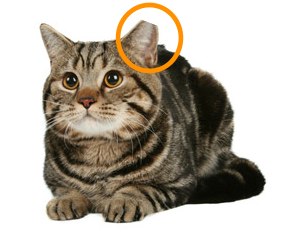If you have noticed free-roaming cats in your neighborhood, it is recommended that you contact a local TNR group or animal shelter to seek further guidance. It is possible that the cats are already being managed...and their caretakers may be looking for help with this, if you're interested!
 One way to tell if a cat is part of a managed colony is to look for whether any of the cats appear to have an "eartip," which is the removal of the top portion of their LEFT ear. This is done during a spay/neuter surgery and indicates that the cat may be part of, or was part of, a managed cat colony. It also indicates that the cat has received at least one rabies vaccine.
One way to tell if a cat is part of a managed colony is to look for whether any of the cats appear to have an "eartip," which is the removal of the top portion of their LEFT ear. This is done during a spay/neuter surgery and indicates that the cat may be part of, or was part of, a managed cat colony. It also indicates that the cat has received at least one rabies vaccine.
Generally, it is not recommended for untrained persons to trap these cats as there is a safe and humane way to do so, and not following those procedures could result in injury to you and/or the cat.
If you are feeding a colony of cats, there are also best practices for this, to prevent wildlife from entering the colony, and to make trapping easier on surgery days. Leaving out bags/piles of food is not advised, for the reasons mentioned above, and for other health and safety reasons.
WANT TO HELP COMMUNITY CATS?
Please view our list of active cat programs to see if there is a group doing work in your area, as they may be in need of help, and will provide training and further education about community cats and their needs.
If you are interested in learning more about TNR in general, community cats, and colony management, here are some reputable national resources:
Alley Cat Allies
Neighborhood Cats
Best Friends Animal Society TNVR